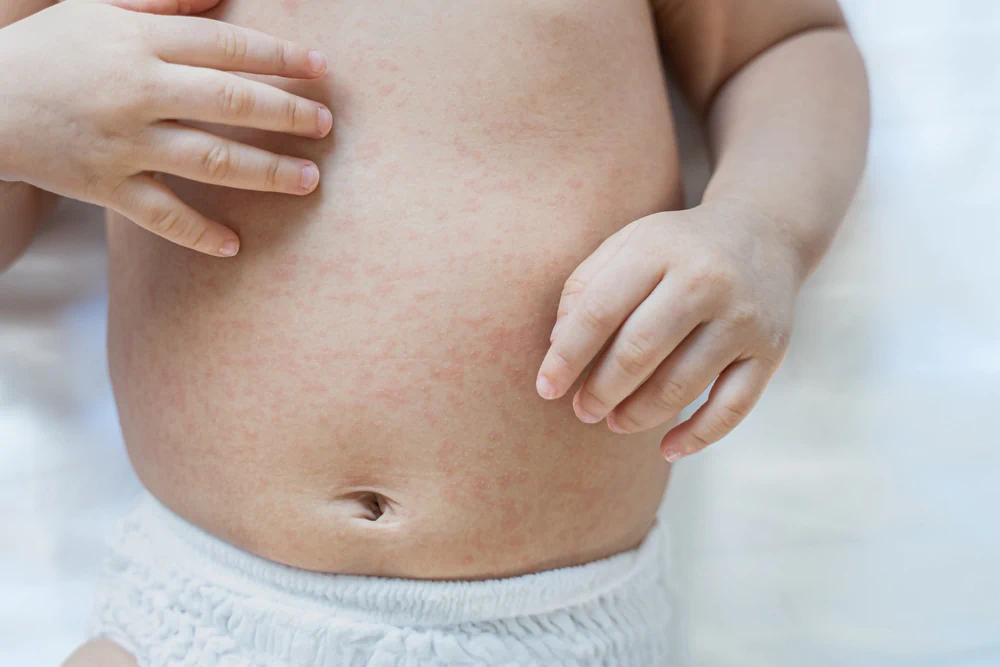Measles Symptoms and Treatment
Uncategorized
•
Mar 4, 2025
Reviewed by: Jeffrey Peebles, M.D

When it comes to childhood illnesses, measles is one that parents typically have on their radar. While vaccines have made this viral infection much less common than before, knowing what to look for is still important — especially with the appearance of recent measles outbreaks in Texas.
| Measles symptoms in adults | Measles symptoms in babies |
| High fever with muscle aches and headaches | Sudden high fever with irritability |
| Red-brown spreading rash | Red-brown spotty rash |
| Severe cough | Cough and runny nose |
| Light sensitivity and eye swelling | White spots in the mouth |
| Extreme fatigue | Decreased feeding and lethargy |
Have a feeling something’s not right? The team at Complete Care’s freestanding ER locations is here to help, day or night. Our doors are always open, and our medical staff is ready to check things out and get treatment started if needed.
What are the symptoms of measles?
These are some of the common symptoms of measles we see at our emergency care facilities:
- High fever
- Measles rash
- Small white spots in the mouth
- Cough
- Runny nose
- Pink eye
- Weakness
- Fatigue
- Loss of appetite
If you or someone in your family shows these symptoms of measles, don’t wait — visit your nearest Complete Care location for proper diagnosis and treatment.
High fever
One of the first signs of measles is a high fever, typically reaching 103°F to 105°F (39.4°C to 40.5°C). While high fevers are also common with RSV symptoms and treatments, measles fever appears about 10 to 12 days after exposure to the virus, marking the beginning of what doctors call the prodromal phase. During this time, you might experience periods where the fever spikes and falls, which can be particularly uncomfortable and concerning for both adults and children.
The measles rash
The characteristic measles rash is perhaps the most recognizable symptom. So, what does measles look like? Unlike roseola infantum virus, which appears as the fever breaks, the measles rash usually appears 3 to 5 days after the initial fever, starting as flat red spots at the hairline and behind the ears. Within days, these spots merge and spread downward across the face, neck, body, arms, and legs. The rash isn’t just a surface change — it often feels raised and can be accompanied by itching.
Koplik’s spots
These tiny white spots inside the mouth are unique to measles and typically appear before the external rash. They look like grains of salt against a red background and are usually found on the inner lining of the cheeks. Medical professionals consider Koplik’s spots a crucial early indicator of measles infection, helping distinguish it from other conditions like bronchitis.
The three C’s
What are the 3 C’s of measles? Measles brings a trio of respiratory symptoms: cough, coryza (runny nose), and conjunctivitis (pink eye). While these symptoms might initially resemble walking pneumonia symptoms, they can be more severe and persistent with measles, making breathing uncomfortable and causing significant eye irritation. The cough is typically dry and can last for several days to weeks, while the conjunctivitis makes eyes sensitive to light.
Fatigue and weakness
Beyond the visible symptoms, measles causes significant fatigue and weakness. Don’t be fooled; this isn’t just ordinary tiredness — it’s a deep exhaustion that can make even simple activities challenging. The body is working hard to fight the virus, which depletes energy reserves and can leave you feeling completely drained.
Loss of appetite
Many people with measles experience a noticeable decrease in appetite. This symptom, combined with fever and fatigue, can lead to dehydration and weight loss if not carefully managed. Staying hydrated and maintaining nutrition becomes particularly important during this time.
How long is measles contagious?
How long do measles last? Measles symptoms typically develop in stages and can last for several days to weeks. Someone with measles can be infected for approximately eight days: four days before the appearance of the rash and four days after.
The virus can be spread by respiratory droplets that occur from coughing, sneezing, or even touching a contaminated service. If you or your child has measles, make sure to isolate during the eight-day period to avoid spreading the virus.
What is the best treatment for measles?
While there’s no specific antiviral treatment for measles itself, supportive care is essential for managing symptoms and preventing complications. Here’s how healthcare providers at Complete Care typically approach measles treatment:
- Rest and isolation: Due to measles being highly contagious, staying home and away from others is necessary since the virus can live in the air for up to two hours after an infected person leaves the room. Isolating for the full eight days (four before and after the rash appears) can encourage a speedy recovery.
- Fever management: Managing fever is essential through over-the-counter fever reducers like acetaminophen or ibuprofen, cool compresses for comfort, maintaining appropriate fluid intake, and regular temperature monitoring to ensure the fever stays under control.
- Hydration support: This includes regular intake of clear fluids, oral rehydration solutions when needed, IV fluids in cases of severe dehydration, and careful monitoring of urine output and color to ensure adequate hydration.
- Vitamin A supplementation: The World Health Organization recommends vitamin A supplements for children with measles, as it can help prevent eye damage and reduce illness severity. Healthcare providers will determine the appropriate dosage based on age and condition.
- Eye care: For patients experiencing sensitivity and inflammation, treatment includes maintaining dim lighting in the recovery environment, regular cleaning of eye discharge, wearing protective eyewear when necessary, and avoiding digital screens to reduce eye strain.
- Respiratory support: To manage breathing difficulties, treatment may include using humidified air to ease coughing, maintaining proper positioning for comfortable breathing, monitoring respiratory rate and oxygen levels, and providing additional intervention if breathing problems develop.
When it comes to measles, the sooner treatment begins, the better equipped your body will be to fight the virus and prevent potential complications. While measles must run its course, proper medical care can significantly ease symptoms and ensure a smoother recovery process.
When should you go to the ER for measles?
Wondering when to be concerned about measles? While measles typically runs its course with supportive care, certain symptoms require immediate medical attention. Watch for these warning signs that indicate you should seek emergency care right away:
- Difficulty breathing: Including labored breathing, rapid breathing, or chest pain with breathing.
- Severe dehydration: Watch for signs like dry mouth, decreased urination, dark urine, severe thirst, dizziness, or lethargy.
- In babies, signs include no wet diapers for 4-6 hours, no tears when crying, or a sunken soft spot on the head.
- High fever that persists: If the fever rises above 104°F (40°C) or remains high despite fever-reducing medications.
- Neurological changes: Any signs of confusion, extreme drowsiness, seizures, or severe headache.
- Vision problems: Blurred vision, eye pain, or sensitivity to light that becomes severe.
- Severe cough: A cough that becomes increasingly worse, produces bloody mucus, or causes significant chest pain.
Remember, measles can be particularly dangerous for certain groups, including:
- Infants and young children
- Pregnant women
- People with weakened immune systems
- Adults over 20 years old
- Malnourished children
These individuals should be monitored especially closely for any worsening symptoms. It’s always better to err on the side of caution when dealing with measles complications.
Protect what matters most. Come to Complete Care for your measles symptoms today.
Whether you’re dealing with symptoms of measles in infants, children, or adults, early medical attention is vital for proper care and preventing complications.
With locations across Austin, Corpus Christi, Dallas/Fort Worth, East Texas, Lubbock, San Antonio, and Colorado Springs, Complete Care’s dedicated medical teams are ready to provide the expert care you need.
Our freestanding emergency rooms offer the same level of care as hospital-based ERs but with shorter wait times and a more personalized experience. Don’t let uncertainty delay your care — visit your nearest Complete Care location today for prompt diagnosis and treatment of measles symptoms.
More Helpful Articles by Complete Care:
- How to Reduce High Blood Pressure
- Why Do I Feel Sick After Traveling?
- Should I Go to The Doctor For a Pulled Muscle
- Does Health Insurance Cover Your Freestanding ER Bill?
- How to Be Prepared For Medical Emergencies at Home
